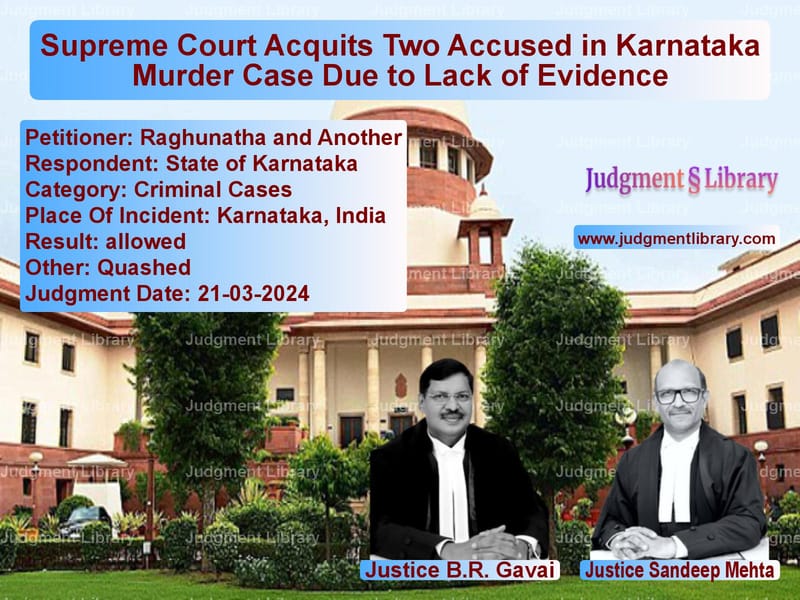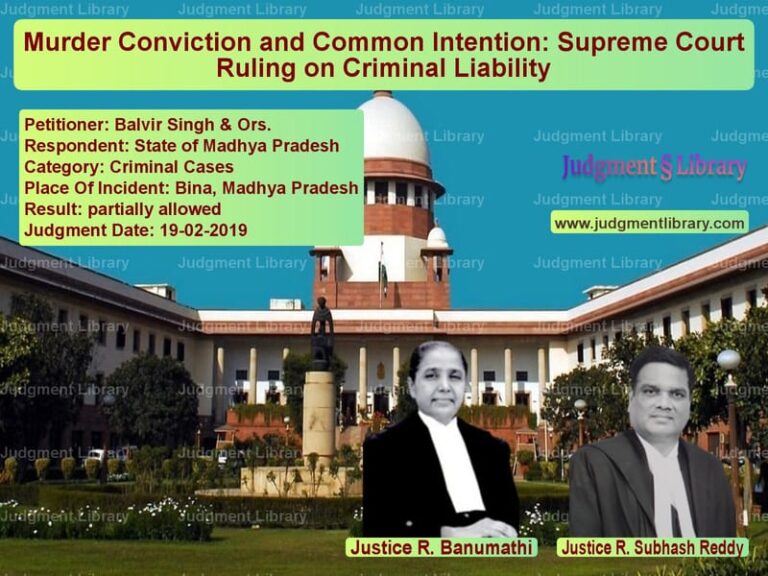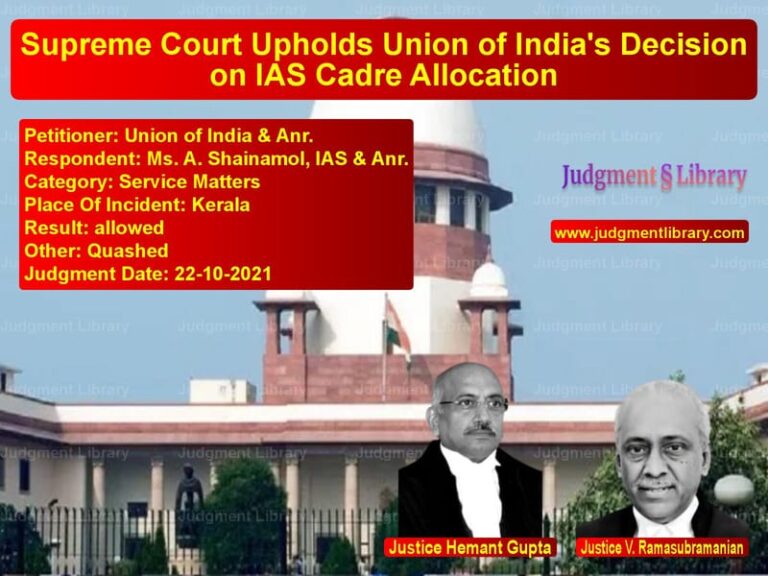Supreme Court Acquits Two Accused in Karnataka Murder Case Due to Lack of Evidence
The Supreme Court of India recently delivered a significant ruling in Raghunatha and Another v. State of Karnataka, acquitting two accused individuals in a murder case due to insufficient circumstantial evidence. The case involved the killing of a man named Ramu, and the prosecution relied entirely on circumstantial evidence to establish the guilt of the accused. The judgment reinforced the long-standing principle that circumstantial evidence must form a complete chain of events leading to only one conclusion: the guilt of the accused.
Background of the Case
The case began with the registration of Crime No. 44/2014 at Kaamasamudram police station in Karnataka following the discovery of the deceased, Ramu. The complaint was lodged by Sri R. Lokanathan on July 7, 2014. The investigation led to the arrest of Accused No. 1, Raghunatha, and Accused No. 2, Manjunatha, who were subsequently charged under Sections 120-B (criminal conspiracy) and 302 (murder) of the Indian Penal Code (IPC).
Prosecution’s Case
The prosecution contended that the accused had a long-standing enmity with the deceased due to financial disputes. The case was built on the following key points:
- Ramu, the deceased, was involved in agriculture and money lending.
- Accused No. 1 had suffered financial losses due to dealings with Ramu and developed animosity.
- On the morning of July 7, 2014, Ramu left home on a TVS moped to collect money from borrowers.
- The accused allegedly ambushed him on a secluded road and attacked him with sharp weapons.
- Accused No. 1 reportedly restrained Ramu, while Accused No. 2 inflicted fatal blows.
- Ramu was found severely injured and taken to KGF Hospital, where he succumbed to his injuries.
The prosecution presented circumstantial evidence, including witness testimonies, forensic reports, and the recovery of a weapon.
Trial Court and High Court Rulings
Based on the circumstantial evidence, the trial court convicted the accused under Sections 120-B and 302 read with Section 34 IPC, sentencing them to life imprisonment. Upon appeal, the Karnataka High Court modified the conviction to Section 304 Part-I IPC (culpable homicide not amounting to murder) and reduced the sentence to 10 years.
Petitioners’ Arguments
The defense challenged the conviction, highlighting the following inconsistencies:
- The entire case was based on circumstantial evidence without direct proof.
- The prosecution failed to establish an unbroken chain of events pointing exclusively to the accused.
- The ‘last seen’ theory was weak, as no witness could confirm the accused were with the deceased immediately before the murder.
- The recovery of the murder weapon was from an open location accessible to the public.
- There was no clear forensic evidence linking the accused to the crime scene.
Respondents’ Arguments
The prosecution defended the conviction, asserting:
- The accused had a strong motive, as Ramu had financial dealings with them.
- The accused were last seen near the crime scene, strengthening the circumstantial evidence.
- The weapon recovered from the scene had traces of blood matching the victim.
- Even though the case was based on circumstantial evidence, the chain of events sufficiently established guilt.
Supreme Court’s Observations
The Supreme Court meticulously analyzed the evidence and found the following discrepancies:
- Weak Last Seen Theory: The Court noted that there was no credible witness who could place the accused with the deceased at the time of the murder.
- Unreliable Recovery Evidence: The alleged recovery of the murder weapon from an open area weakened its evidentiary value.
- Absence of Direct Motive Proof: While financial disputes were cited as a motive, no strong evidence linked the accused to a premeditated act.
- Chain of Circumstantial Evidence Incomplete: The Court reiterated that circumstantial evidence must form a complete and unbroken chain that leaves no room for alternate theories.
The Court referenced the landmark case of Sharad Birdhichand Sarda v. State of Maharashtra (1984), emphasizing:
“Circumstantial evidence must be complete and incapable of any other hypothesis except the guilt of the accused. A mere suspicion, however strong, cannot take the place of proof.”
Key Judicial Remarks
The Supreme Court made the following strong observations:
“The suspicion, however strong, cannot take the place of proof beyond reasonable doubt. An accused cannot be convicted on mere conjecture.”
On the importance of proper evidence, the Court stated:
“The prosecution must establish each link in the chain of circumstances beyond a reasonable doubt. Any break in the chain vitiates the case against the accused.”
Final Judgment
Based on these findings, the Supreme Court ruled:
- The convictions of the accused were set aside.
- The accused were acquitted of all charges.
- The accused were to be released immediately unless required in any other case.
Implications of the Judgment
This ruling has significant implications:
- Reaffirms the Standard for Circumstantial Evidence: It reinforces that courts must ensure a complete chain of evidence before convicting accused individuals.
- Prevents Miscarriages of Justice: The judgment highlights the importance of ensuring that convictions are based on reliable and conclusive proof.
- Sets a Precedent for Lower Courts: It serves as guidance for trial courts when evaluating cases based solely on circumstantial evidence.
- Upholds Fundamental Rights: The judgment reiterates that every accused is entitled to a fair trial and the benefit of the doubt in the absence of conclusive proof.
Conclusion
The Supreme Court’s decision in Raghunatha and Another v. State of Karnataka serves as a crucial reminder that justice must be based on evidence, not assumptions. By acquitting the accused due to the prosecution’s failure to establish an unbroken chain of circumstances, the Court has reinforced the principles of fairness and due process in criminal trials. This ruling is expected to influence how lower courts handle circumstantial evidence cases in the future.
Read also: https://judgmentlibrary.com/supreme-court-acquits-man-in-alleged-rape-case-citing-lack-of-evidence/
Petitioner Name: Raghunatha and Another.Respondent Name: State of Karnataka.Judgment By: Justice B.R. Gavai, Justice Sandeep Mehta.Place Of Incident: Karnataka, India.Judgment Date: 21-03-2024.
Don’t miss out on the full details! Download the complete judgment in PDF format below and gain valuable insights instantly!
Download Judgment: raghunatha-and-anoth-vs-state-of-karnataka-supreme-court-of-india-judgment-dated-21-03-2024.pdf
Directly Download Judgment: Directly download this Judgment
See all petitions in Murder Cases
See all petitions in Bail and Anticipatory Bail
See all petitions in Fraud and Forgery
See all petitions in Judgment by B R Gavai
See all petitions in Judgment by Sandeep Mehta
See all petitions in allowed
See all petitions in Quashed
See all petitions in supreme court of India judgments March 2024
See all petitions in 2024 judgments
See all posts in Criminal Cases Category
See all allowed petitions in Criminal Cases Category
See all Dismissed petitions in Criminal Cases Category
See all partially allowed petitions in Criminal Cases Category







